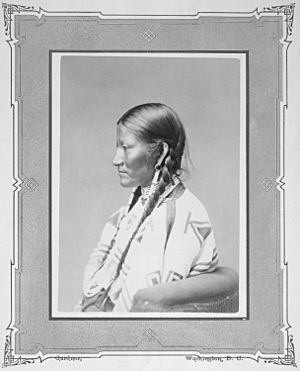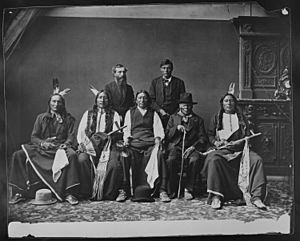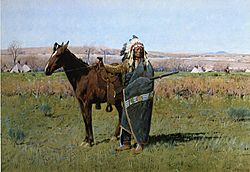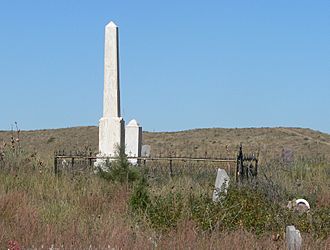Spotted Tail facts for kids
Quick facts for kids
Spotted Tail
|
|
|---|---|
| Siŋté Glešká (birth name Jumping Buffalo) | |
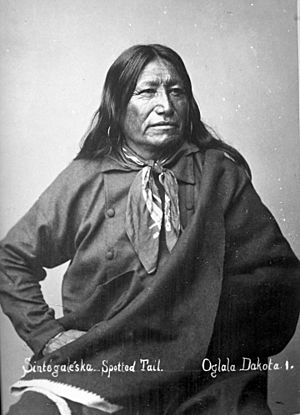
Chief Spotted Tail
|
|
| Brulé Lakota leader | |
| Personal details | |
| Born | c. 1823 Present-day South Dakota |
| Died | August 5, 1881 South Dakota |
| Resting place | Rosebud, South Dakota, U.S. 43°14′28″N 100°51′11″W / 43.24111°N 100.85306°W |
| Relations | Sisters, Iron Between Horns and Kills Enemy |
| Children | Ah-ho-appa (Fallen Leaf) |
| Parents | Father, Cunka or Tangle Hair; mother, Walks-with-the-Pipe |
| Education | Sinte Gleska University named for him, 1971 |
| Known for | Statesman and warrior, with interests in peace and education |
Spotted Tail (whose name in the Lakota language was Siŋté Glešká, pronounced gleh-shka) was an important Brulé Lakota tribal chief. He was born around 1823 and passed away on August 5, 1881. His birth name was T'at'aŋka Napsíca, meaning "Jumping Buffalo."
Even though he was a brave warrior when he was young, Spotted Tail later became a leader who worked for peace. He believed that fighting against the white settlers moving into their lands would not help his people. Instead, he chose to be a statesman, speaking up for his tribe's rights and trying to find peaceful solutions. He visited Washington, D.C. several times in the 1870s to represent his people. He was also known for wanting to bring education to the Sioux people. Spotted Tail was killed in 1881 by another subchief named Crow Dog, due to disagreements that are still debated today.
Contents
Early Life and Name
Spotted Tail was born around 1823 near the White River in what is now South Dakota. His father, Cunka (also called Tangle Hair), was from the Saône band. His mother, Walks-with-the-Pipe, was Brulé. He was given the birth name Jumping Buffalo.
Over the 40 years before his birth, the Lakota (or Teton Sioux) people had moved west. They traveled from areas like present-day Minnesota and eastern South Dakota to lands west of the Missouri River. During this time, they learned to use horses, which helped them hunt buffalo across their large grazing areas. The Lakota people also formed different groups, such as the Saône, Brulé, and Oglala.
Spotted Tail got his warrior name after a white trapper gave him a raccoon tail. He sometimes wore this raccoon tail on his war bonnet. He was also related to the famous warrior Crazy Horse through his sisters, Iron Between Horns and Kills Enemy, who married Crazy Horse's elder relative.
General Anson Mills, who knew Spotted Tail well, described him as a kind and loyal man. He said Spotted Tail loved peace and believed that war would not help his people. He also had great respect for U.S. Army officers and a good sense of humor.
Family and Important Events
Spotted Tail was married and had children. One of his daughters was named Ah-ho-appa, which means "Fallen Leaf." An army officer named Eugene Fitch Ware wrote that Fallen Leaf was a unique person. She seemed to adopt some European-American customs.
When Fallen Leaf was dying in 1866, she asked her father to promise that she would be buried on a hillside overlooking Fort Laramie. Spotted Tail honored her wish. The entire army group at the fort helped him arrange a special funeral. It included both a Christian service and a traditional Sioux ceremony.
Working for Peace and Treaties
Spotted Tail agreed to the Treaty of Fort Laramie in 1868. This treaty created the Great Sioux Reservation west of the Missouri River. In 1871, Spotted Tail visited Washington, D.C. to meet with the Commissioner of Indian Affairs, Ely S. Parker, and President Ulysses S. Grant. While there, he also met Red Cloud, another important Lakota chief. They both agreed to work together to protect the rights and lands of the Sioux people.
The Black Hills and Conflict
In 1874, a military group led by George Armstrong Custer explored Sioux territory. They reported finding gold in the Black Hills, which was a sacred area for the local Native American tribes. The Army tried to keep miners out, but many still came, causing tensions to rise.
In May 1875, delegations led by Spotted Tail, Red Cloud, and Lone Horn traveled to Washington, D.C. They made a final effort to convince President Grant to honor the existing treaties. They wanted to stop the flow of miners into their lands. The Native American leaders met with President Grant and other officials. They were told that Congress wanted to offer the tribes $25,000 for their land. The government also suggested moving them to a new area called Indian Territory.
Spotted Tail and the other leaders refused this offer. Spotted Tail explained his feelings clearly: "My father, I have thought about what the Great Father told me, and I am here to give you an answer.... When I was here before, the President gave me my country, and I chose a good place to live, and I want to stay there.... I respect the Treaty, but the white men who come into our country do not. You speak of another country, but it is not my country; it does not concern me, and I want nothing to do with it. I was not born there.... If it is such a good country, you should send the white men who are now in our country there and leave us alone...."
Spotted Tail's Death
On August 5, 1881, Spotted Tail was killed by Crow Dog on the Rosebud Indian Reservation. There had been a long-standing disagreement between them. Crow Dog was arrested and tried in a court in Deadwood, Dakota Territory. He was found guilty of murder and sentenced to death.
However, the case went to the United States Supreme Court. The Supreme Court decided that the Deadwood court did not have the power to judge a case where one Native American killed another on reservation land. Because of this, Crow Dog was released and went back to the Rosebud Reservation.
Some people believed that white officials said the killing was just a quarrel over a woman. But Spotted Tail's friends thought it was part of a plan to weaken the power of the chiefs.
Spotted Tail is buried in Rosebud, South Dakota. A tribal university, Sinte Gleska University, was named after him in 1971. It is located on the Rosebud Indian Reservation in South Dakota.
|
See also
 In Spanish: Sinte Galeshka para niños
In Spanish: Sinte Galeshka para niños


